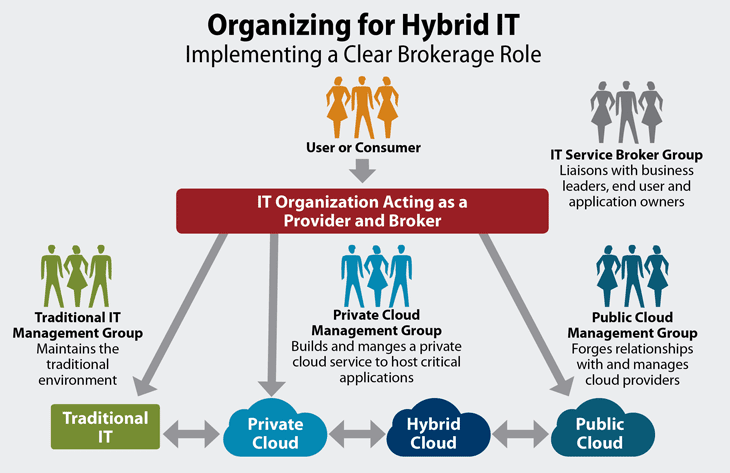Datamation content and product recommendations are
editorially independent. We may make money when you click on links
to our partners.
Learn More
Hybrid IT is an enterprise computing model in which the organization provides some resources through traditional in-house IT systems while also leveraging some combination of cloud computing services for other resources.
As evidenced by its prevalence, hybrid IT remains a more workable approach for most organizations than either going entirely cloud-free or relying exclusively on public cloud and/or private cloud.
Cloud Storage and Backup Benefits
Protecting your company’s data is critical. Cloud storage with automated backup is scalable, flexible and provides peace of mind. Cobalt Iron’s enterprise-grade backup and recovery solution is known for its hands-free automation and reliability, at a lower cost. Cloud backup that just works.
SCHEDULE FREE CONSULT/DEMO
The hybrid IT cloud architecture – whether public or private – is characterized by scalability based on demand, easy provisioning by users, and measured and metered usage.
Many providers have stepped to the plate with public cloud services in the areas of SaaS (software as a service), IaaS (infrastructure as a service), and PaaS (platform as a service), relieving customers from needing to install and manage similar resources in-house
Hybrid IT can also focus on private clouds. Unlike multi-tenant public clouds, private clouds use a single-tenant architecture. Private clouds are generally operated in on premise data centers, although private cloud hosting services are certainly available.
Even with the proliferation of public cloud services, most companies are continuing to keep at least some of their resources in-house, outside of any cloud environment. This is due to security and privacy concerns, or the technical challenges associated with migrating complex legacy systems to a cloud architecture.

Hybrid IT Solutions
In the most common type of hybrid IT solution today, an organization continues to run and maintain key IT resources in traditional IT environments, either on premise or on a hosted basis, while using other resources from multiple public cloud providers.
Some customers, however, are relying on hybrid IT only as an interim solution, with an eye to eventual migration of all IT resources to the cloud.
There are three types of public cloud solutions that may integrate with a hybrid IT model:
SaaS
- The largest public cloud market today, SaaS uses the web to deliver apps managed by a third-party vendor. Most SaaS apps can be accessed by the organization’s end users directly from a web browser. Typically provided on a monthly subscription or pay-per-use basis, SaaS eliminates the need to install and manage applications on enterprise servers and PCs, along with associated CapEx expenditures for hardware and software licenses.
- Popular SaaS companies include office suites, email and collaboration, CRM, HR, accounting, and ERP, for instance. Google Apps, Cisco WebEx, Salesforce.com, SAP One, and Citrix GoToMeeting are a few of the most widely used SaaS apps.
IaaS
- IaaS is characterized by self-service services for accessing, monitoring, and managing remote infrastructures. A cloud provider hosts the infrastructure components traditionally present in an on-premises data center, including servers, storage and networking hardware, plus a virtualization or hypervisor layer.
- Typically, the provider also supplies services such as monitoring, billing, log access, security, load balancing and clustering, and data backup, replication and recovery.
- In a public cloud IaaS, the provider charges for hosting and other services based on consumption. Customers can log into services over a wide area network (often the Internet) for purposes like troubleshooting applications and managing disaster recovery. Also, IaaS services are increasingly policy-driven, allowing users to implement greater levels of automation and orchestration.
- Many startups rent or lease IaaS services instead of buying their own data center hardware and software.
- Some long established enterprises, however, include IaaS within their hybrid IT models. IaaS is used, for instance, to expand the in-house data center for handling temporary workloads during high demand periods, such as the Christmas shopping season.
- Although IaaS is most often run in the public cloud, solutions are also available as private clouds for use within companies’ own data centers.
PaaS
- PaaS builds on IaaS by providing software component middleware frameworks which IT organizations can use to either build new apps or customize existing apps. Geared to agile DevOps, PaaS is designed to make it easier and more cost effective to develop, test, and deploy customer apps.
- Services are frequently delivered through a hybrid IT model which uses both public cloud IaaS and in-house IT resources, but other delivery methods include a hybrid cloud model combining private and public clouds and a private PaaS which uses only a private cloud. Of all the “as a service” offerings, PaaS is moving past hybrid IT most rapidly. Already, nearly half of all PaaS services are cloud-only, according to a recent report by Gartner.
- In the highly fragmented PaaS space, providers include Amazon Electronic Beanstalk, Apprenda, Cloud Foundry, Google App Engine (GAE), SAP Cloud Platform, and Software AG Cloud, to name a few.
Hybrid IT Infrastructure
- In SaaS-only implementations of hybrid IT, some applications are moved to the public cloud, but infrastructure and software development components remain in a traditional in-house IT environment.
- In implementations of hybrid IT involving IaaS and/or PaaS, some infrastructure and/or development components are migrated to the public cloud, while other IT resources are housed in a traditional in-house IT environment. However, public cloud-enabled resources can be accessed and managed in-house.
Examples of Hybrid IT
- A manufacturer might keep a highly customized mainframe production application running on premise to avoid the complexities of rewriting the app, while adopting SaaS apps from the cloud to replace outmoded legacy client-server apps in areas like ERP, HR, and CRM.
- A bank might adhere to regulatory requirements by continuing to secure customer information in a traditional on-premise data center, while also launching a hybrid cloud ecosystem to host innovative fintech startup partners.
- An interstate trucking firm might choose to run a highly proprietary app in a hosted private cloud for competitive reasons, while updating its data through integration of meteorological and mapping feeds from a public source.
- A large retailer might retain valuable customer information in an on-premise data center, at the same time saving money by leveraging powerful data analytics tools from the public cloud to slice and dice the data.
- In an iOT app, an electric utility firm might keep its billing system in an on-premise data center while using public cloud services as endpoints for collecting telemetry data from customers’ meters.
Hybrid IT Costs
Pay-as-you go pricing is a major driver behind hybrid IT adoption. By making use of the public cloud, organizations can rent software and hardware as they need it instead of making long-term commitments to purchasing all of the organization’s commercial software licenses and underlying hardware. Existing internal IT staff can be redeployed from application and network administration to other tasks.
Still, by running and managing other IT resources in-house, the organization needs to continue buying some software licenses and hardware upgrades, as well as to keep paying for internal IT management staff and any applicable hosting fees.
Billing by cloud services providers often includes hidden costs which organizations hadn’t anticipated. When multiple public cloud providers are involved, cloud sprawl ensues. Cloud costs and usage can become buried in monthly billing detail across various providers and multiple internal accounts, teams, and business units.
Consequently, organizations need to carefully review billing agreements before committing to public cloud services and to monitor cloud spend in real-time to identify and manage irregularities.
Although the cost benefits of public vs. private clouds constitute a topic of ongoing debate, it’s safe to say that private clouds typically involve considerable consultative fees and management costs. On the other hand, private cloud costs tend to be more transparent. While use of public clouds is still much more typical, hybrid IT can embrace both private and public clouds.
Hybrid IT Pros and Cons
Pros:
- Organizations can continue to exert control, security, privacy, and regulatory compliance over sensitive resources by keeping those resources in-house.
- At the same time, less sensitive resources can be migrated to agile and easily scalable cloud environments.
- A hybrid IT environment brings together the fixed costs of in-house IT systems with the variable costs of cloud services, allowing for more flexible planning around IT spend.
Cons:
- Many hybrid IT environments are still happening “by accident,” without a strategic plan in place for selecting types of resources according to the requirements of the workload.
- The SaaS apps typically used in hybrid IT cloud deployments today are not as customizable as homegrown in-house apps.
- Management and integration can be more challenging under a hybrid IT model than in either an entirely cloud or totally cloudless environment.
SEE ALL
CLOUD ARTICLES








